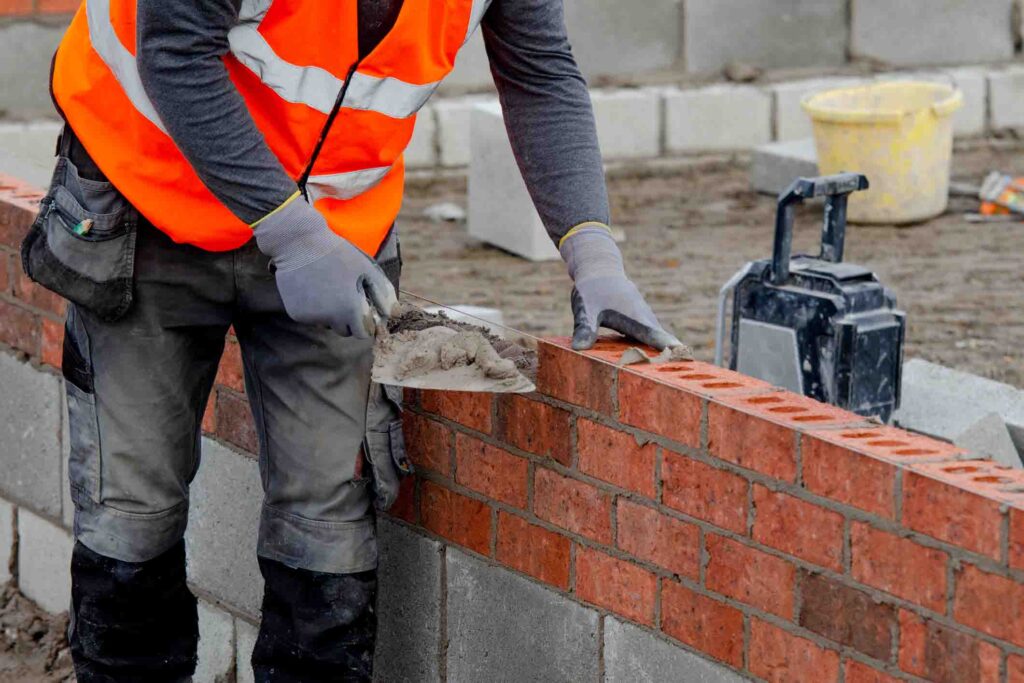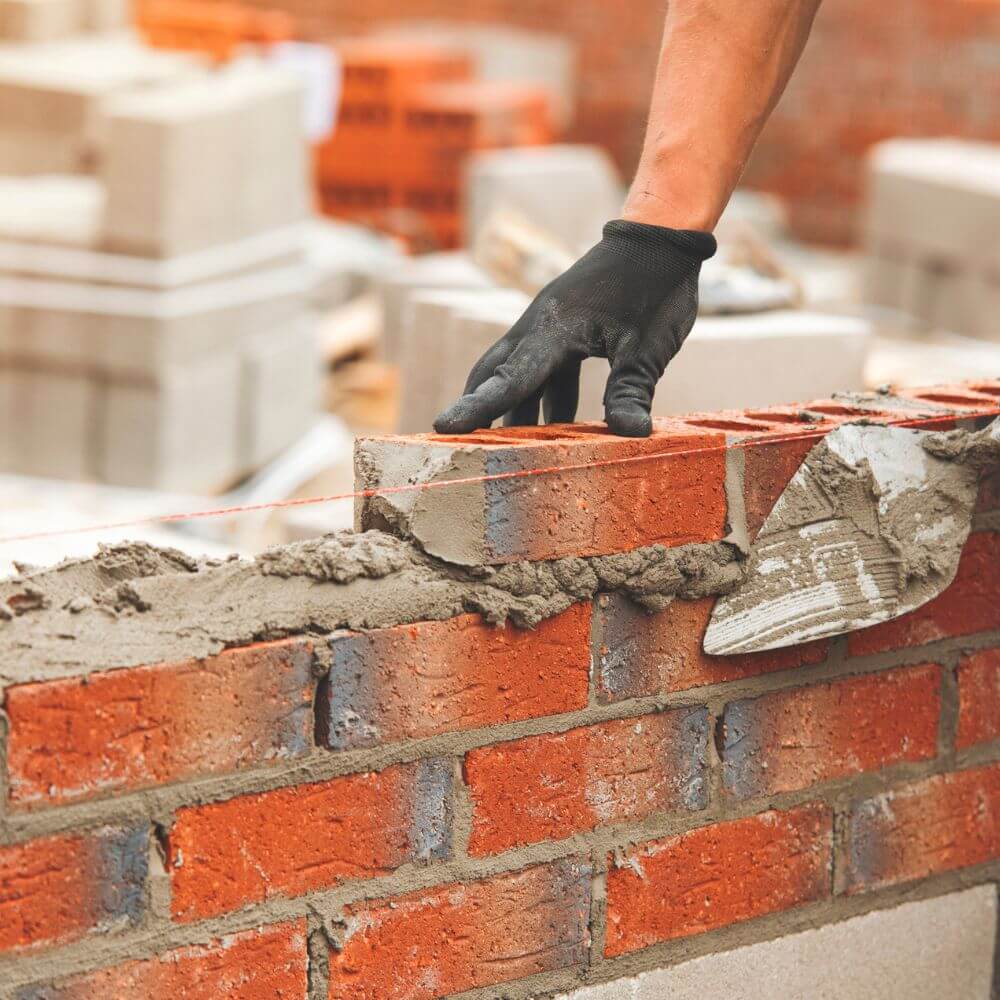Table of contents
Table of contents
Do you love working with your hands, enjoy being outdoors, or want a career with solid earning potential, then bricklaying could be a great fit for you.
With the governments ambitious house building plans the construction industry is under pressure to deliver on building targets. However, it’s widely reported that there is a shortage of bricklayers, with numbers at their lowest in the UK, since 1998.* With 1.5 million new builds targeted it is estimated that 20,000* more bricklayers will be required, one of the most in demand trades across the construction industry. So, if you’re deciding on a trade for yourself, bear in mind that bricklayers can earn more than other trades – this might be an option to consider.
We’ve constructed an overview of the bricklayer landscape to help you assess if it’s the right direction for you. We’ll walk you through what bricklayers do, how to get trained, career pathways, earnings, and even how to start your own bricklaying business.
What do bricklayers do?
Bricklayers (or brickies) are the backbone of construction projects. Their job isn’t just stacking bricks – there’s a lot of skill involved – correctly laying bricks and concrete blocks that are built to last. There’s also work that involves other materials to build walls, homes, offices, and even grand architectural structures. As a bricklayer your main areas of work will be:
- Reading construction plans and blueprints
- Mixing and applying mortar
- Ensuring walls are level and sturdy
- Repairing and restoring old buildings
- Working with various materials like bricks, blocks, and natural stone
If you like the idea of seeing the physical results of your work every day, bricklaying can be a very satisfying job.
Day-to-day bricklaying
There’s a wide variety to a bricklayer’s day but let’s look at a typical one:
Morning: Site prep & first bricks
Most bricklayers start early, usually by 7:30 AM. The day begins with checking plans, preparing materials, and setting up the work area. Once ready, you’ll start laying bricks, ensuring everything is level and secure using a spirit level and trowel.
Midday: Progress & coordination
After a short morning break, work continues, often coordinating with labourers, site supervisors, and other trades. Tasks might include cutting bricks to size, mixing mortar, and checking progress against blueprints. Then a midday lunch break.
Afternoon: Finishing & clean-up
The afternoon is spent progressing with the build, adding details like pointing (smoothing out mortar joints) for a neat finish. By 4 PM, tools are cleaned, the site is tidied, and the next day’s work is planned.
Essential skills for a bricklayer

To be a great bricklayer, you don’t need top grades in school, but you do need a good work ethic, and these specific skills will certainly help you out:
- Physical fitness: It’s a hands-on job that involves lifting, bending, and working outdoors.
- Attention to detail: No one wants wonky walls!
- Basic maths skills: You’ll need to measure, cut, and calculate materials.
- Good coordination: Bricklaying requires precision and accuracy.
- Problem-solving ability: Every project is different, and you’ll need to think on your feet.
- Teamwork: You’ll often be working with other tradespeople, from plumbers to electricians.
Average earnings for bricklayers and job outlook
Earnings vary depending on location and experience, but here’s a rough guide:
- Apprentice Bricklayer – £12,000 – £18,000 per year
- Qualified Bricklayer – £25,000 – £40,000 per year
- Highly Experienced Bricklayer – £50,000+
- Self-Employed Bricklayer – Potentially £60,000+ (more on that below)
The construction industry in the UK is growing, so skilled bricklayers will always be needed. To learn more read our blog on how much bricklayers make in the UK.
Training to become a bricklayer

Bricklaying is a skilled trade and you’ll need some valuable training to get started. There are different options to suit your preferred learning process or depending on where you are in life.
Apprenticeships (Best for hands-on learning)
Usually take around 2-3 years and result in an NVQ Level 2 or 3 in Bricklaying.
An apprenticeship is the most common way to become a bricklayer in the UK. You’ll earn while you learn, usually working four days a week with a bricklaying company and spending one day at college.
College courses (Ideal for career changers)
If you’re over 16 and want a structured way to learn, many colleges offer bricklaying diplomas or NVQs. Courses range from beginner to advanced levels, and while you won’t get paid while studying, they’re a good way to gain the skills needed for an apprenticeship or junior job. These courses are often more flexible with evening or weekend options to fit around other work.
On-the-job training
Some people start as a labourer and learn on the job. This can be a great way to get experience, and after a while, your employer may sponsor you to gain formal qualifications.
Qualifications
Whilst it’s not a requirement, if you’re looking to reach for the top jobs having a qualification will stand you in good stead. City and Guilds offer a few options. Here are some examples of different courses available:
- Level 2 Technical Certificate in Bricklaying
- Level 3 Advanced Technical Diploma in Bricklaying
- Apprenticeship Bricklayer Level 2
- Apprenticeship Craft Bricklayer Level 3
Career pathway for bricklayers
Bricklaying isn’t just about working on site all your life (unless that’s what you want!). There are several career progression opportunities:
Apprentice Bricklayer
Starting as an apprentice is the most common route into bricklaying. You’ll gain hands-on experience while earning a wage and working towards industry-recognised qualifications, such as an NVQ (National Vocational Qualification) in Bricklaying. Apprenticeships typically last around two to three years and involve a mix of on-site training and classroom learning at a college or training centre.
Qualified Bricklayer
Once you’ve completed your apprenticeship and achieved your NVQ, you’ll be recognised as a fully qualified bricklayer. This opens the door to working on a wide range of construction projects, from housing developments to commercial buildings and even large-scale infrastructure projects. As a qualified bricklayer, you can expect to earn a competitive wage and continue developing your skills on the job.
Specialist Bricklayer
If you’re interested in refining your expertise, you could specialise in areas such as:
- Restoration & Conservation: Working on historic buildings and listed structures, carefully repairing or recreating brickwork in line with heritage standards.
- Decorative Brickwork: Creating detailed brick patterns, arches, and ornamental designs that add architectural interest to buildings.
- Refractory Brickwork: Installing heat-resistant bricks in industrial settings like furnaces, kilns, and chimneys.
Specialising can set you apart in the industry and may allow you to command higher rates for your expertise.
Site Supervisor / Foreman
With experience and strong leadership skills, you could step up into a supervisory role. As a site supervisor or foreman, you’ll be responsible for overseeing a team of bricklayers, ensuring work is completed to a high standard and within deadlines. This role involves managing materials, liaising with other trades, and ensuring health and safety regulations are met on site.
Construction Manager
If you’re ambitious and willing to take on further qualifications, such as an HNC, HND, or even a degree in Construction Management, you could progress to overseeing entire building projects. As a construction manager, you’d be responsible for budgeting, scheduling, and coordinating multiple aspects of a project, from planning to completion. This role comes with significant responsibility but also a higher earning potential.
Self-Employed Bricklayer
Fancy being your own boss? Many bricklayers choose to go self-employed, allowing them to set their own rates, choose their projects, and even build their own client base. Running your own business can be rewarding, but it also comes with added responsibilities such as managing finances, sourcing work, and handling customer relations.
How to become a self-employed bricklayer
If you want to be your own boss and earn more money, going self-employed could be a great option. Here’s what you’ll need:
- Experience – Clients will want proof of your skills.
- CSCS Card – Required for most UK construction sites.
- Tools and Transport – You’ll need your own kit and a van.
- Business Skills – Managing finances, quoting jobs, and finding clients.
- Marketing – A website, social media, and word-of-mouth can help you get work.
Many self-employed bricklayers start by doing weekend jobs or small side projects before going fully independent.
Typical tools and equipment used by bricklayers

When you become a bricklayer, especially if you’re self-employed, you’ll want to start building up a range of tools, your typical toolkit should include:
- Trowels – For spreading mortar
- Spirit Level – To keep everything straight
- Hammer & Chisel – For shaping bricks
- Brick Jointer – To create neat mortar lines
- Mixing Tools – For preparing cement and mortar
Safety gear, such as gloves, steel-toe boots, and a hard hat, is also essential.
Challenges and benefits of a bricklaying career
Like any job, bricklaying has its ups and downs.
Pros:
- Job security – always in demand
- Good earnings potential
- Work outdoors, not stuck in an office
- Great for people who enjoy hands-on work
Cons:
- Physically demanding work
- Working in all weather conditions
- Early mornings and long hours
Starting a bricklaying business

If you’re ready to take the first step towards a career in bricklaying, here’s what to do:
- Look for apprenticeships: Check sites like the UK Government’s apprenticeship portal.
- Find a college course: Many local colleges offer bricklaying diplomas.
- Gain work experience: Even unpaid work experience can help you get your foot in the door.
- Network with professionals: Speak to builders and bricklayers in your area for advice.
- Get your CSCS card: Most construction sites require this for safety reasons.
Bricklaying is a rewarding, hands-on career with great prospects. Whether you’re looking to start as an apprentice, switch careers, or even go self-employed, there’s plenty of opportunity in this field. So, if you like the sound of working with bricks and building something real, why not give it a go?
Get Bricklayers Insurance from Protectivity
*Disclaimer – This blog has been created as general information and should not be taken as advice. Make sure you have the correct level of insurance for your requirements and always review policy documentation. Information is factually accurate at the time of publishing but may have become out of date.
Last updated by

















